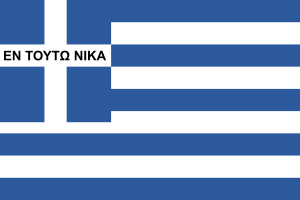Kallergis family
This article has multiple issues. Please help or discuss these issues on the talk page. (Learn how and when to remove these template messages)
|

The Kallergis family (Greek: Καλλέργης) is a Cretan Greek aristocratic family which claims descent from Byzantine Emperor Nikephoros II Phokas,[2][3][4] and were at one stage the most powerful noblemen of Crete.
Origin[]
According to later tradition, Emperor Alexios II Komnenos sent twelve noble Byzantine families to Crete, in order to strengthen the ties between the island and Constantinople. The families were credited important land and administrative privileges. Ioannis Phokas was one of those 12 Byzantine rulers.[5]
The Phokas name changed to "Kallergis" during the Venetian dominion over Crete, which began in the aftermath of the Fourth Crusade. As Richard von Coudenhove-Kalergi describes in his book An idea conquers the world the Kallergis name is composed of the Greek word kalon (=beautiful) and ergon[6] (from ergō="work, task, deed, accomplishment, or purpose") [Greek: Καλλ(ι)έργης > Καλλέργης, known in many versions as Kalergis, Calergis, Kallergi, Callergi, Calergi].
Large areas of Crete were attributed to each of those families. That is the reason that villages named Kallergiana
[7] (Greek: Καλλεργιανά) in Kissamos or Kallergo [8] (Greek: Καλλέργω ή Καλλέργο) in Rethymno exist today. On the White Mountains (Greek: Lefkà Ori, Λευκά Όρη) there is also a mountain hill called Kallergis (altitude 1.650 meters).
Heraldic ensembles containing the Kallergis family coat of arms (bendy argent and azure) can be found all over the island of Crete, in churches and other monuments.[9] The name reappears many times in the turbulent history of Crete but also of modern Greece.
Their prominent position and privileges survived during the Venetian dominion of Crete as they were part of the "privilegiati" (Greek: Αρχοντορωμαίοι) and sometimes of "nobili Veneti".[10] They served many times the Venetian regime but at the same time defended the welfare of the Cretan people, being involved in several uprisings, most notably the Revolt of Alexios Kallergis in the late 13th century.[11]
During the Venetian dominion and after the Ottoman conquest of the island of Crete (1669 AD) many of the Kallergis moved to the Ionian islands and Euboea, Venice and Russia.
In Venice the family, hereafter named Calergi in this branch, built bonds with the families of Vendramin, Crespi and Grimani through marriages .
The family is also connected to the Palazzo Vendramin-Calergi, which is found in Venice on the Grand Canal.
See also[]
| Wikimedia Commons has media related to Kallergis family. |
- Calliergis, a genus of moths of the family Noctuidae
- Calliergis ramosa, a moth of the family Noctuidae
References[]
- ^ "Η Ελληνική Σημαία" (PDF) (in Greek). Γενικό Επιτελείο Στρατού. 2003. p. 39. Retrieved 28 October 2015.
Η σημαία των αδελφών Καλλέργη. Μοιάζει αρκετά με τη σημερινή ελληνική σημαία. (Translation: The flag of the Kallergis brothers. It looks very similar to today's Greek flag)
{{cite web}}: CS1 maint: url-status (link) - ^ Alice-Mary Talbot,Denis F. Sullivan: The History of Leo the Deacon: Byzantine Military Expansion in the Tenth Century. Dumbarton Oaks, 2005, Book II, p. 80
- ^ David Holton (ed.), Literature and society in Renaissance Crete, Cambridge University Press 1991, p. 80
- ^ Melchior Vogüé (marquis de), Charles Henri Auguste Schefer: Revue de l'Orient latin, Volume 11 p. 111
- ^ "Crete, the 12 young rulers from Byzantium".
- ^ Richard Nicolaus Coudenhove-Kalergi (Graf von)An idea conquers the world, Roy Publishers 1954, p. 4
- ^ "Google Maps".
- ^ "Google Maps".
- ^ Examples of the Kallergis/Callergi arms
- ^ Nikolaos Panagiōtakēs/Roderick Beaton: El Greco, The cretan years, Ashgate Publishing, Ltd., 2009, p. 63 and ss.
- ^ , Uncommon dominion:Venetian Crete and the myth of ethnic purity, University of Pennsylvania Press, 2000, p. 74 and ss.
- Greek noble families
- Kallergis family
- Kingdom of Candia